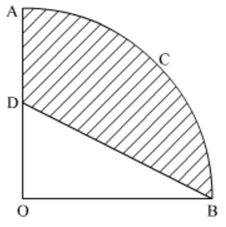 Short Answer Type
Short Answer TypeIf the equation (1 + m2) x2 + 2mcx + c2 – a2 = 0 has equal roots then show that c2 = a2 (1 + m2).
The 3/4th part of a conical vessel of internal radius 5 cm and height 24 cm is full of water. The water is emptied into a cylindrical vessel with internal radius 10 cm. Find the height of water in a cylindrical vessel.
In the given figure, OACB is a quadrant of a circle with centre O and radius 3.5 cm. If OD = 2 cm, find the area of the shaded region.
Two tangents TP and TQ are drawn to a circle with centre O from an external point T. Prove that ∠PTQ = 2 ∠OPQ.
Show that ΔABC, where A(–2, 0), B(2, 0), C(0, 2) and ΔPQR where P(–4, 0), Q(4, 0), R(0, 2) are similar triangles.
The area of a triangle is 5 sq units. Two of its vertices are (2, 1) and (3, –2). If the third vertex is (7/2, y), find the value of y.
Two different dice are thrown together. Find the probability that the numbers obtained
(i) have a sum less than 7
(ii) have a product less than 16
(iii) is a doublet of odd numbers.
The outcomes when two dice are thrown together are
(1,1), (1,2), (1,3), (1,4), (1,5), (1,6)
(2,1), (2,2), (2,3), (2,4), (2,5), (2,6)
(3,1), (3,2), (3,3), (3,4), (3,5), (3,6)
(4,1), (4,2), (4,3), (4,4), (4,5), (4,6)
(5,1), (5,2), (5,3), (5,4), (5,5), (5,6)
(6,1), (6,2), (6,3), (6,4), (6,5), (6,6)
Total number of outcomes = 36
(i) Let A be the event of getting the numbers whose sum is less than 7.
The outcomes in favour of event A are (1, 1), (1,2), (1,3), (1,4), (1,5), (2,1), (2,2), (2,3), (2,4), (3,1), (3,2), (3,3), (4,1), (4,2) and (5,1).
Number of favourable outcomes = 15
(ii) Let B be the event of getting the numbers whose product is less than 16.
The outcomes in favour of event B are (1,1), (1,2), (1,3), (1,4), (1,5), (1,6), (2,1), (2,2), (2,3), (2,4), (2,5), (2,6), (3,1), (3,2), (3,3), (3,4), (3,5), (4,1), (4,2), (4,3), (5,1), (5,2), (5,3), (6,1) and (6,2).
Number of favourable outcomes = 25
iii) Let C be the event of getting the numbers which are doublets of odd numbers.
The outcomes in favour of event C are (1,1), (3,3) and (5,5).
Number of favourable outcomes = 3
A moving boat is observed from the top of a 150 m high cliff moving away from the cliff. The angle of depression of the boat changes from 60° to 45° in 2 minutes. Find the speed of the boat in m/h.
 Long Answer Type
Long Answer Type